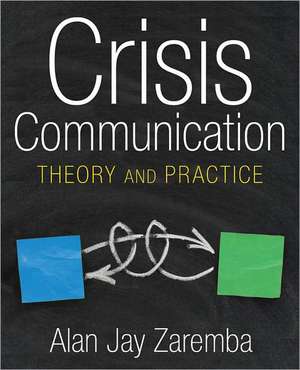Crisis Communication: Theory and Practice
Autor Alan Jay Zarembaen Limba Engleză Paperback – 15 mar 2010
The subject of crisis communication has evolved from a public relations paradigm of reactive image control to an examination of both internal and external communication, which requires proactive as well as reactive planning. There are many challenges in this text, for crisis communication involves more than case analysis; students must examine theories and then apply these principles. This text prepares students by:
- Providing a theoretical framework for understanding crisis communication
- Examining the recommendations of academics and practitioners
- Reviewing cases that required efficient communication during crises
- Describing the steps and stages for crisis communication planning
| Toate formatele și edițiile | Preț | Express |
|---|---|---|
| Paperback (1) | 461.87 lei 43-57 zile | |
| Taylor & Francis – 15 mar 2010 | 461.87 lei 43-57 zile | |
| Hardback (1) | 1550.35 lei 43-57 zile | |
| Taylor & Francis – 15 apr 2010 | 1550.35 lei 43-57 zile |
Preț: 461.87 lei
Preț vechi: 543.38 lei
-15% Nou
Puncte Express: 693
Preț estimativ în valută:
88.41€ • 96.06$ • 74.31£
88.41€ • 96.06$ • 74.31£
Carte tipărită la comandă
Livrare economică 21 aprilie-05 mai
Preluare comenzi: 021 569.72.76
Specificații
ISBN-13: 9780765620521
ISBN-10: 0765620529
Pagini: 256
Dimensiuni: 189 x 246 x 18 mm
Greutate: 0.48 kg
Ediția:New.
Editura: Taylor & Francis
Colecția Routledge
Locul publicării:Oxford, United Kingdom
ISBN-10: 0765620529
Pagini: 256
Dimensiuni: 189 x 246 x 18 mm
Greutate: 0.48 kg
Ediția:New.
Editura: Taylor & Francis
Colecția Routledge
Locul publicării:Oxford, United Kingdom
Public țintă
Professional and UndergraduateRecenzii
"By including a wide range of case studies, exercises, and practitioner perspectives from both the private and nonprofit sectors, Crisis Communication: Theory and Practice sets the stage for an interactive classroom experience. It provides a strong conceptual framework, as well as the real-life examples that bring the subject of crisis communication to life."
— Carl Zangerl, Northeastern University
"Crisis Communication: Theory and Practice brings the subject of crisis communication to life. It not only offers a knowledge set but each chapter provides practitioner perspectives and exercises to develop skills. The book offers professionals clear insights into one of the most demanding but fulfilling areas of public relations and gives academics a solid understanding of a schoarly area that will only gain importance over tiem. All in all, it's an exceptional read."
-- Joyce M. Wolburg, Journal of Consumer Marketing
"By including a wide range of case studies, exercises, and practitioner perspectives from both the private and nonprofit sectors, Crisis Communication: Theory and Practice sets the stage for an interactive classroom experience. It provides a strong conceptual framework, as well as the real-life examples that bring the subject of crisis communication to life."
— Carl Zangerl, Northeastern University
"I strongly recommend this book...it is appropriate for a variety of communication or business classes. Practicing managers who are involved in crisis planning will also find it a valuable resource. In addition to being concise and clearly written, the examples motivate the reader to consider how crisis communication works within their organizations." -- Lizabeth A. Barclay, Busniess Communication Quarterly
"This text is a nice contribution to the study of crisis communication. It is suitable for upper-level undergraduates and graduate students interested in the study of crisis communication and management. It would also be a welcome addition the the library of anyone interested in pursuing this line of study." -- Granville King III, International Journal of Communication
— Carl Zangerl, Northeastern University
"Crisis Communication: Theory and Practice brings the subject of crisis communication to life. It not only offers a knowledge set but each chapter provides practitioner perspectives and exercises to develop skills. The book offers professionals clear insights into one of the most demanding but fulfilling areas of public relations and gives academics a solid understanding of a schoarly area that will only gain importance over tiem. All in all, it's an exceptional read."
-- Joyce M. Wolburg, Journal of Consumer Marketing
"By including a wide range of case studies, exercises, and practitioner perspectives from both the private and nonprofit sectors, Crisis Communication: Theory and Practice sets the stage for an interactive classroom experience. It provides a strong conceptual framework, as well as the real-life examples that bring the subject of crisis communication to life."
— Carl Zangerl, Northeastern University
"I strongly recommend this book...it is appropriate for a variety of communication or business classes. Practicing managers who are involved in crisis planning will also find it a valuable resource. In addition to being concise and clearly written, the examples motivate the reader to consider how crisis communication works within their organizations." -- Lizabeth A. Barclay, Busniess Communication Quarterly
"This text is a nice contribution to the study of crisis communication. It is suitable for upper-level undergraduates and graduate students interested in the study of crisis communication and management. It would also be a welcome addition the the library of anyone interested in pursuing this line of study." -- Granville King III, International Journal of Communication
Cuprins
Chapter 1 Foundations for Crisis Communication; Chapter 2 Defining Crisis Communication; Chapter 3 Organizational Theory and Crisis Communication; Chapter 4 Planning for Crises; Chapter 5 Responding to Crises; Chapter 6 Ethical Issues in Crisis Communication; Chapter 7 Crisis Communication Teams; Chapter 8 Training the Spokesperson; Chapter 9 Where Do You Go from Here?;
Descriere
Crisis Communication adds theoretical coverage and practical application to the more traditional study of crisis communication through case analysis. It prepares students by providing a theoretical framework for understanding, examining the recommendations of academics and practitioners, and describing the steps and stages for communication planning. It is designed for upper undergraduate students and does not require familiarity with relevant theory. Each chapter includes Chapter Objectives, Case Study, Practitioner Perspective, and Exercises, and an online Instructor's Manual is available to adopters.
















